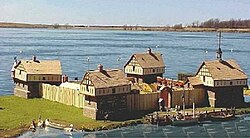Fort Beauharnois
Today, Fort Beauharnois is still a relevant topic in society. With the growing importance of this issue, it is crucial to understand its implications and consequences. In this article, we will explore different aspects related to Fort Beauharnois, from its history to its impact today. Through detailed analysis, we seek to provide a complete and objective view of Fort Beauharnois, with the aim of fostering greater understanding and discussion on the topic. Regardless of your level of knowledge about Fort Beauharnois, we hope that this article is informative and sparks your interest in learning more about this very important topic today.
| Fort Beauharnois | |
|---|---|
 A model of Fort Beauharnois at the Musée de la civilisation in Quebec City | |
| Location | Florence Township, Goodhue County, Minnesota, USA |
| Built | 1727 |
| Rebuilt | 1730 |
Fort Beauharnois was a French fort, serving as a fur trading post and Catholic mission, built on the shores of Lake Pepin, a wide section of the upper Mississippi River, in 1727. The location chosen was on lowlands and the fort was rebuilt in 1730 on higher ground. It was the site of the first Roman Catholic chapel in what is now Minnesota, which was dedicated to St. Michael the Archangel. The fort was named after the Governor of New France at the time, Charles de Beauharnois.
Eventually it was abandoned as the French sent most of their troops to the east to fight the British in the French and Indian War.
Today, an Ursuline convent and the Villa Maria Conference Center stand on the site of the old fort, in Florence Township of Goodhue County, in the Roman Catholic Archdiocese of Saint Paul and Minneapolis. The Minnesota Department of Transportation inventories a roadside historical marker of the presumed location of the fort along US 61/US 63
See also

- Pierre-Charles Le Sueur, one of the first French explorers to visit the upper Mississippi River in 1699
- Jacques Legardeur de Saint-Pierre, commanded the fort from 1734 to May 1737